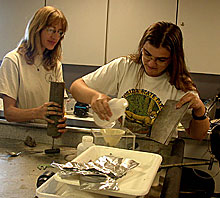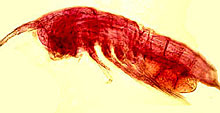
Dr. Sandra Brooke (University of Oregon, left) assists Linda Sedlecik (Florida State University, right) in preparing mud cores for later analysis. Click image for a larger view.
Tiny Creatures from the Sea-floor Mud
October 15, 2002
Linda Sedlacek
Florida State University
A cold front passed through the Gulf of Mexico yesterday, bringing 30 knot winds and waves more than 10 feet tall. It is dangerous to launch and recover the submersible under such conditions, so we spent much of the past two days working in the lab and waiting for the weather to clear. Today, we attempted a dive at the brine pool, but it was ended after just a short stay on the bottom because of building seas. Bad weather gives us a great opportunity to examine some of the microscopic animals that we are collecting and the microscopic embryos being cultured in our shipboard laboratory.
Most of our exploratory work is focused on large, spectacular animals that can be seen and collected with the hydraulic claw and scoop of the submersible. However, large animals are somewhat exceptional in the deep sea; the most common animals, the so-called meiofauna, cannot be seen from a submersible window because they are microscopic and hide in the mud. Some of the most abundant and diverse meiofaunal animals are known as harpacticoid copepods. These crustaceans bear some resemblance to shrimp, but they are generally smaller than 1 mm in length. Although they are widely distributed in the marine environment and are often very abundant in the surface sediments, their occurrence at cold seeps is virtually unknown. A few new species have recently been found near seeps off the coast of California. Until now, there have been no investigations of harpacticoid copepods from seeps in the Gulf of Mexico and at least some of those we expect to find on this cruise are likely to be new to science.

A harpacticoid copepod collected from mud in the Gulf of Mexico. This specimen, a female carrying eggs, has been stained red to make it stand out from the rest of the sample. Click image for larger view.
Linda Sedlecik, a student of Professor David Thistle at Florida State University, is collecting mud samples near seeps for her studies of harpacticoid copepods. She collects them using tube cores, simple tubes of plastic that are inserted into the bottom to remove undisturbed plugs of mud. The mud is kept inside by a cork in the bottom and a spring-loaded valve on the top. Using the submersible, we can select precise places to insert these cores. Back in the shipboard laboratory, Linda pushes the mud slowly out of the tube and cuts it into thin slices. She then places the samples in liquid nitrogen to freeze the samples quickly. Over the next year or so, these frozen samples will be carefully examined with a microscope to sort out the harpacticoids from other organisms in the sediment. Any new species will be described and the health of the animals will be assessed by examining their fat (lipid) stores with fluorescent dyes. When food is plentiful and the organisms eat a lot, they build up their lipids, and in times of little food they use up their lipid stores.
Sign up for the Ocean Explorer E-mail Update List.























